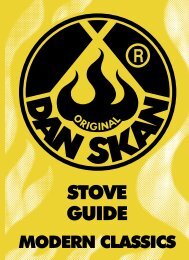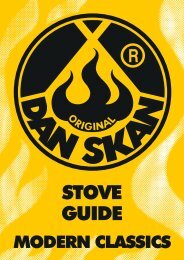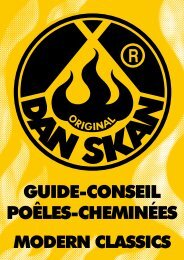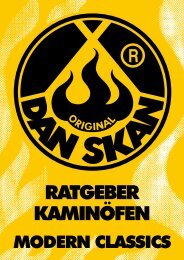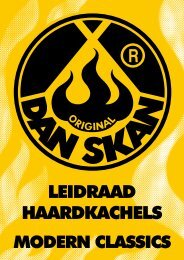STOVE GUIDE - DanSkan
STOVE GUIDE - DanSkan
STOVE GUIDE - DanSkan
Create successful ePaper yourself
Turn your PDF publications into a flip-book with our unique Google optimized e-Paper software.
EX-AIR<br />
BURNING WITH EXTERNALLY SUPPLIED COMBUSTION AIR<br />
Increasingly throughout Europe many DAN SKAN stoves are being installed in ‘energy-saving’ or low-energy houses, which are<br />
insulated to very high standards and where potential heat loss, and therefore the movement of air, is minimised. In Germany they<br />
have their own strict building standard covering external air known as DIBt with which the new DAN SKAN Modern Line stoves<br />
comply. Each of our models feature an external air (also known as direct air) inlet option where a connection pipe is used to draw<br />
combustion air from outside the house. The DAN SKAN EX-AIR system automatically delivers tertiary air, which is pre-heated to<br />
300º C as it travels through a series of channels into the combustion chamber where it then enters the after-burning process, just<br />
above the top of the flames. This ensures that the fire chamber is not continuously cooled by the colder external air.<br />
EX-AIR-1: CLASSIC SYSTEM WITH PRE-HEATED TERTIARY AIR<br />
C<br />
A<br />
Patented<br />
Automatic<br />
Tertiary Air<br />
Heat-Zone<br />
D<br />
B<br />
~120<br />
Each DAN SKAN Classic stove has the option of supplying the external combustion<br />
air from the base (A), where the 100mm diameter connecting pipe<br />
can be concealed below the floor or hearth, or from the rear of the stove (B).<br />
Outdoor air has the potential to be extremely cold so that pre-heating this air<br />
supply is essential to ensure the efficient performance of fire chamber. Both of<br />
these options allow a much longer time for the outdoor air to draw heat from<br />
the rear of the stove as it moves through pre-heating channels towards the<br />
inlet at the top of the fire chamber as normal room pressure pre-heated<br />
Tertiary air (C).<br />
Thousands of stoves with the DAN SKAN EX-AIR-1 system have proven themselves<br />
in low-energy or passive houses because, with this system, it means<br />
that the stove acts like a potential pressure balancing safety valve. The external<br />
air inlet at the base or rear of the stove, connects with the internal air via the<br />
stove‘s convection system ensuring that excessive negative pressure in the<br />
installation room, and the potential problems this could cause with the stove‘s<br />
safe operation, are avoided.<br />
If negative pressure is created in the room where the stove is located and this<br />
pressure is higher than inside the chimney system, then additional air can be<br />
fed into the room out of the convection aperture at the rear top of the DAN<br />
SKAN stove (D).<br />
Ø 100<br />
C<br />
EX-AIR 2: EXTERNAL AIR SYSTEM WHICH DOES NOT USE<br />
INTERNAL AIR<br />
A<br />
Patented<br />
Automatic<br />
Tertiary Air<br />
Heat-Exchanger<br />
D.S. Patent !<br />
D<br />
~120<br />
B<br />
Ø 100mm<br />
The EX-AIR 2 supplies combustion air via a sealed, ventilation and internal airindependent<br />
system, and is especially suitable for modern low-energy houses<br />
with high seal windows as well as doors and pressure balance control. This<br />
system requires the installation of the DAN SKAN patented AIR-BOX which<br />
includes an integrated heat exchanger. The AIRBOX can also be added at a<br />
later date since all DAN SKAN stove back plates feature a pre-prepared laser<br />
cut aperture which can be easily removed to allow the new connection. As<br />
with the EX-AIR 1 system each stove has the option of supplying the external<br />
combustion air from the base (A), where the 100 mm diameter connecting pipe<br />
can be concealed below the floor or hearth, or from the rear of the stove (B).<br />
Within the enclosed AIRBOX the combustion air is pre-heated by the integrated<br />
heat exchanger at the rear of the fire box (D) before it is delivered automatically<br />
in the correct amount, into the fire chamber as tertiary air (C). This<br />
ensures a very high post-combustion air temperature in the upper part of the<br />
fire chamber to feed the top of the flames and to make the stove operate with<br />
much greater efficiency while also making it much cleaner burning. The highest<br />
negative pressure is in the area just above the baffle plate and this allows the<br />
pre-heated tertiary air to be efficiently drawn in.<br />
When using the EX-AIR-2 system there is no need to use the pull control or to<br />
open the stove door to supply combustion air when lighting a standard fire as<br />
special air vents at the door sides provide the correct amount of air to get the<br />
pre-fire started.<br />
Please note: Some Building Regulations do not permit ‘closing off’ the external<br />
air supply, even when the stove is not being used. Please refer to your local<br />
and national building regulations.<br />
If this is prohibited, DAN SKAN recommend that suitable precautions are therefore<br />
taken to avoid potential condensation forming on the external air duct as<br />
it enters the warmer room, for example insulating the air duct.<br />
74



